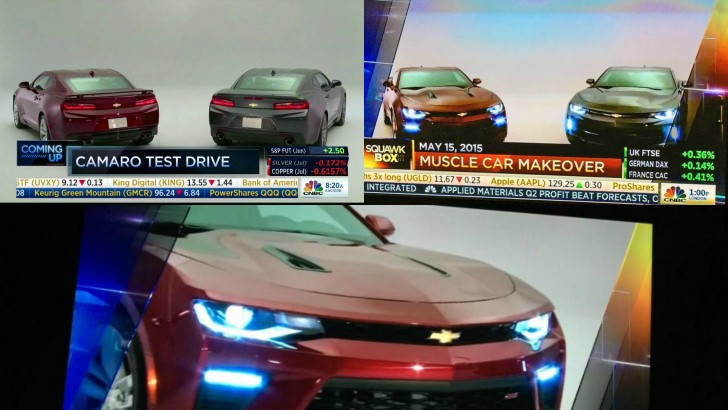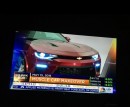Just after two GMI forum members uploaded the first pictures of the 2016 Chevrolet Camaro, further intel surfaced on the sixth-generation Camaro. Without further ado, here's the 2016 Camaro's engine lineup – 2-liter turbocharged four-cylinder, 3.6-liter naturally aspirated V6 and a 6.2-liter naturally aspirated V8.
According to "a reliable inside source," the Jalopnik crew was purportedly offered exact output figures for the initial engine lineup of the 2016 Chevrolet Camaro. So how does the new kid on the pony/muscle car block stack up output-wise against its main competitors?
In the 2016 Cadillac CT6's case, the 2-liter engine is rated 265 horsepower and it's mated as standard to an all-new eight-speed automatic (the Hydra-Matic 8L45).
By comparison, the entry-level Mustang is animated by an atmospheric 3.7-liter V6 with 300 HP and 280 lb-ft (379 Nm) on tap. As for the 3.6-liter Pentastar V6 in the 2015 Dodge Challenger SXT, this naturally aspirated mill makes do with 305 horsepower and no less than 268 lb-ft (363 Nm) of RWD twist.
The middle-of-the-range 2016 Camaro is going head to head with the 2016 Ford Mustang EcoBoost. The 2.3-liter unit in the FoMoCo machine develops 310 HP and 320 lb-ft (433 Nm). As far as the ponderous 2015 Dodge Challenger R/T is concerned, the Mopar machine is rated 375 HP and 410 lb-ft (555 Nm) of torque from its atmospheric 5.7-liter HEMI V8.
Coupled to the fast-shifting Hydra-Matic 8L90 eight-speed automatic and, most probably, the 7-speed manual of the C7 Corvette, the 2016 Chevrolet Camaro SS will be a thoroughly neat V8 proposition.
Considering that all intel hints towards a 2016 Camaro SS lighter than the 2016 Ford Mustang GT and Dodge Challenger 392 HEMI, this is going to be interesting. Output-wise, the Mustang's 5.0 Coyote V8 churns a meaty 435 horsepower and 400 lb-ft (542 Nm). On the other hand, the 392 HEMI 6.4-liter eight-cylinder blunderbuss is the most powerful at 485 horsepower and 470 lb-ft (637 Nm).
On an ending note, we expect the sixth-gen Camaro ZL1 to adopt the 2016 Cadillac CTS-V and 2016 Corvette Z06's LT4 supercharged V8, with a maximum output of 640 horsepower and 630 pound-feet (854 Nm). Will there ever be a powerful enough Camaro to take on the Hellcat? It's mum's guess. We hope that the upcoming Z/28 will be able to make the 2016 Shelby GT350 Mustang put its money where its mouth is.
UPDATE: Jalopnik posted a GM insider's memo on the 2016 Chevrolet Camaro, as follows:
Technology
• All-new Driver Mode Control, which tailors up to eight vehicle attributes – from the dual-mode exhaust to throttle progression
• Magnetic Ride Control suspension, which is offered on the Camaro SS for the first time
• Segment-exclusive, Interior Spectrum Lighting that offers 24 different ambient lighting settings – and offers a “car show” mode
• High-definition, configurable color displays – including available dual 8-inch screens
• Available wireless phone charging and next-generation Chevrolet MyLink with new smartphone projection
Performance
• GM’s award-winning Alpha architecture enables a more nimble, responsive driving experience
o The new Camaro is at least 200 pounds lighter than previous model
o Although based on Alpha, 70 percent of the components are unique to Camaro
• The most powerful Camaro SS ever
o 6.2L LT1with estimated at 440 horsepower and 450 lb-ft of torque
• All-new 3.6L V-6 featuring direct injection, continuously variable valve timing and –for the first time – Active Fuel Management (cylinder deactivation)
o Estimated 330 horsepower and 275 lb-ft of torque
• Most efficient Camaro ever, delivering more than 30 MPG highway
o New 2.0L Turbo with an estimated 270 hp and 290 lb-ft
• Handling and performance for the Camaro SS approaches that of the fifth-generation models’ track-capable Camaro 1LE package
Design
• More athletic-looking, sculptured exterior that complements the tighter, leaner architecture
• Aerodynamically optimized design is the result of 350 hours of wind tunnel testing – with reduced drag on LT models and 30 percent improvement in lift downforce on SS
• All-new, driver-focused interior with intuitive controls, flat-bottom steering wheel, and high quality materials throughout
• Unique control rings around the air vents used for temperature and fan speed adjustments, eliminating the need for conventional buttons
Expected questions:
Q: When will the new Camaro: start production / go on sale / arrive at dealers?
A: We are not ready to discuss specific timing, but can tell you we expect the first Camaros to arrive at dealers by the end of 2015.
Q: How much will the Camaro cost? Will it be more/less than the current Camaro?
A: We are not ready to announce pricing. I can tell you the current Camaro ranges from $23,000 to $43,000 and we expect the new Camaro will have a similar range.
Q: Why is the Alpha-based Camaro “only” 200 pounds lighter that the old Camaro? The fifth-gen was so heavy, it should have been 500 pounds lighter.
A: A 200 pound savings is actually quite remarkable: The Alpha-architecture is very mass-efficient, however the exterior dimensions of the new Camaro are within 2 inches of the predecessor. The team looked for every opportunity to save mass –from increased use of aluminum to shortening the suspension bolts to save a few grams. The result can be immediately felt behind the wheel – as the new Camaro feels incredibly light, agile, and fun to drive.
Q: How fast will the 2.0L Turbo/V-6/V8 be 0-60/¼-mile/top speed/Lap times?
A: It is too soon to discuss specific performance numbers, as we are currently finalizing the tuning and calibration of the new car. All I can tell you is the new 2016 Camaro SS is already posting better lap times than the 2015 Camaro 1LE.
Q: When will theZ/28 / ZL1 / 1LE arrive?
A: We are not ready to discuss products beyond 2016 model year for competitive reasons. However, I can tell you we plan to introduce new models and special editions at least every year.
Q: Why would you offer a four-cylinder in the Camaro? Didn’t you learn your lesson with the Iron Duke?
A: With the Gen2 Camaro, we learned buyers are not willing to sacrifice performance for fuel economy. As such, the new Camaro 2.0L Turbo is impressive performance: The 2.0L Turbo delivers 270 horsepower – which is more than any V-8 offered from 1971 to 1995 – and it’s paired with a lighter, more nimble chassis that makes the Camaro exceptionally fun-to-drive.
Q: Why are you offering the four-cylinder as your base engine, and V6 as an option, when Mustang offers the V-6 as their base, and their EcoBoost as an upgrade?
A: We felt 4-6-8 was a more logical progression for customers as they look for the balance of performance and efficiency that fits their needs. It’s important to note that Mustang positions their V-6 as a low-volume, low-feature model. To get a well-optioned car, Ford forces you to upgrade to the EcoBoost. We are taking adifferent tact, allowing customers to build a well-equipped Camaro with their choice of engines.
Q : Why didn’t you fix the rearward visibility for the next-gen ? That was the single biggest complaint for the Gen 5.
A: We talked to many Gen 5 customers about the visibility, and they made it clear they were not willing to accept changing the appearance of the Camaro’s iconic silhouette for the sake or rear visibility. We are using increased levels of technology to help with visibility, including a standard back up camera on all models, and available rear sonar.
UPDATE 2: Here's the 2016 Chevrolet Camaro!
- 2-liter LTG turbo four-cylinder engine: 270 HP and 290 lb-ft (393 Nm)
This Cadillac-derived 2-point-oh force-fed four-banger is the entry-level option on the 2016 Chevrolet Camaro. On the GM Alpha-platformed Cadillac CTS, the 2-liter lump churns out a respectable 272 HP.In the 2016 Cadillac CT6's case, the 2-liter engine is rated 265 horsepower and it's mated as standard to an all-new eight-speed automatic (the Hydra-Matic 8L45).
By comparison, the entry-level Mustang is animated by an atmospheric 3.7-liter V6 with 300 HP and 280 lb-ft (379 Nm) on tap. As for the 3.6-liter Pentastar V6 in the 2015 Dodge Challenger SXT, this naturally aspirated mill makes do with 305 horsepower and no less than 268 lb-ft (363 Nm) of RWD twist.
- 3.6-liter LGX V6: 330 HP and 275 lb-ft (372 Nm) of naturally aspirated get-up-and-go
It's a little bit curious how Jalopnik didn't figure it out yet that the mid-range mill in the 2016 Chevrolet Camaro engine lineup is the same as the one propelling the 2016 Cadillac CT6. In the full-size sedan's case, it's mated to the 8L40 eight-speed automatic and develops 335 HP and 284 lb-ft (385 Nm) of torque.The middle-of-the-range 2016 Camaro is going head to head with the 2016 Ford Mustang EcoBoost. The 2.3-liter unit in the FoMoCo machine develops 310 HP and 320 lb-ft (433 Nm). As far as the ponderous 2015 Dodge Challenger R/T is concerned, the Mopar machine is rated 375 HP and 410 lb-ft (555 Nm) of torque from its atmospheric 5.7-liter HEMI V8.
- 6.2-liter LT1 small-block V8: 440 HP and 450 lb-ft (610 Nm)
Now that's more like it! What we were expecting since early 2014 came to fruition: the LS-series small-block V8 is gone and in its place comes the Corvette Stingray's V8 tower-of-power, albeit 10 HP down on the C7.Coupled to the fast-shifting Hydra-Matic 8L90 eight-speed automatic and, most probably, the 7-speed manual of the C7 Corvette, the 2016 Chevrolet Camaro SS will be a thoroughly neat V8 proposition.
Considering that all intel hints towards a 2016 Camaro SS lighter than the 2016 Ford Mustang GT and Dodge Challenger 392 HEMI, this is going to be interesting. Output-wise, the Mustang's 5.0 Coyote V8 churns a meaty 435 horsepower and 400 lb-ft (542 Nm). On the other hand, the 392 HEMI 6.4-liter eight-cylinder blunderbuss is the most powerful at 485 horsepower and 470 lb-ft (637 Nm).
On an ending note, we expect the sixth-gen Camaro ZL1 to adopt the 2016 Cadillac CTS-V and 2016 Corvette Z06's LT4 supercharged V8, with a maximum output of 640 horsepower and 630 pound-feet (854 Nm). Will there ever be a powerful enough Camaro to take on the Hellcat? It's mum's guess. We hope that the upcoming Z/28 will be able to make the 2016 Shelby GT350 Mustang put its money where its mouth is.
UPDATE: Jalopnik posted a GM insider's memo on the 2016 Chevrolet Camaro, as follows:
Technology
• All-new Driver Mode Control, which tailors up to eight vehicle attributes – from the dual-mode exhaust to throttle progression
• Magnetic Ride Control suspension, which is offered on the Camaro SS for the first time
• Segment-exclusive, Interior Spectrum Lighting that offers 24 different ambient lighting settings – and offers a “car show” mode
• High-definition, configurable color displays – including available dual 8-inch screens
• Available wireless phone charging and next-generation Chevrolet MyLink with new smartphone projection
Performance
• GM’s award-winning Alpha architecture enables a more nimble, responsive driving experience
o The new Camaro is at least 200 pounds lighter than previous model
o Although based on Alpha, 70 percent of the components are unique to Camaro
• The most powerful Camaro SS ever
o 6.2L LT1with estimated at 440 horsepower and 450 lb-ft of torque
• All-new 3.6L V-6 featuring direct injection, continuously variable valve timing and –for the first time – Active Fuel Management (cylinder deactivation)
o Estimated 330 horsepower and 275 lb-ft of torque
• Most efficient Camaro ever, delivering more than 30 MPG highway
o New 2.0L Turbo with an estimated 270 hp and 290 lb-ft
• Handling and performance for the Camaro SS approaches that of the fifth-generation models’ track-capable Camaro 1LE package
Design
• More athletic-looking, sculptured exterior that complements the tighter, leaner architecture
• Aerodynamically optimized design is the result of 350 hours of wind tunnel testing – with reduced drag on LT models and 30 percent improvement in lift downforce on SS
• All-new, driver-focused interior with intuitive controls, flat-bottom steering wheel, and high quality materials throughout
• Unique control rings around the air vents used for temperature and fan speed adjustments, eliminating the need for conventional buttons
Expected questions:
Q: When will the new Camaro: start production / go on sale / arrive at dealers?
A: We are not ready to discuss specific timing, but can tell you we expect the first Camaros to arrive at dealers by the end of 2015.
Q: How much will the Camaro cost? Will it be more/less than the current Camaro?
A: We are not ready to announce pricing. I can tell you the current Camaro ranges from $23,000 to $43,000 and we expect the new Camaro will have a similar range.
Q: Why is the Alpha-based Camaro “only” 200 pounds lighter that the old Camaro? The fifth-gen was so heavy, it should have been 500 pounds lighter.
A: A 200 pound savings is actually quite remarkable: The Alpha-architecture is very mass-efficient, however the exterior dimensions of the new Camaro are within 2 inches of the predecessor. The team looked for every opportunity to save mass –from increased use of aluminum to shortening the suspension bolts to save a few grams. The result can be immediately felt behind the wheel – as the new Camaro feels incredibly light, agile, and fun to drive.
Q: How fast will the 2.0L Turbo/V-6/V8 be 0-60/¼-mile/top speed/Lap times?
A: It is too soon to discuss specific performance numbers, as we are currently finalizing the tuning and calibration of the new car. All I can tell you is the new 2016 Camaro SS is already posting better lap times than the 2015 Camaro 1LE.
Q: When will theZ/28 / ZL1 / 1LE arrive?
A: We are not ready to discuss products beyond 2016 model year for competitive reasons. However, I can tell you we plan to introduce new models and special editions at least every year.
Q: Why would you offer a four-cylinder in the Camaro? Didn’t you learn your lesson with the Iron Duke?
A: With the Gen2 Camaro, we learned buyers are not willing to sacrifice performance for fuel economy. As such, the new Camaro 2.0L Turbo is impressive performance: The 2.0L Turbo delivers 270 horsepower – which is more than any V-8 offered from 1971 to 1995 – and it’s paired with a lighter, more nimble chassis that makes the Camaro exceptionally fun-to-drive.
Q: Why are you offering the four-cylinder as your base engine, and V6 as an option, when Mustang offers the V-6 as their base, and their EcoBoost as an upgrade?
A: We felt 4-6-8 was a more logical progression for customers as they look for the balance of performance and efficiency that fits their needs. It’s important to note that Mustang positions their V-6 as a low-volume, low-feature model. To get a well-optioned car, Ford forces you to upgrade to the EcoBoost. We are taking adifferent tact, allowing customers to build a well-equipped Camaro with their choice of engines.
Q : Why didn’t you fix the rearward visibility for the next-gen ? That was the single biggest complaint for the Gen 5.
A: We talked to many Gen 5 customers about the visibility, and they made it clear they were not willing to accept changing the appearance of the Camaro’s iconic silhouette for the sake or rear visibility. We are using increased levels of technology to help with visibility, including a standard back up camera on all models, and available rear sonar.
UPDATE 2: Here's the 2016 Chevrolet Camaro!





